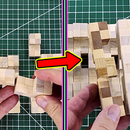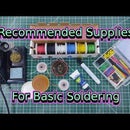Introduction: Soldering Surface Mount Components | Soldering Basics
So far in my Soldering Basics Series, I've discussed enough basics about soldering for you to get started practicing. In this Instructable what I'll be discussing is a bit more advanced, but it is some of the basics for soldering Surface Mount Components without a reflow oven. I'll be assuming that you've already checked out the first 2 Instructables for my Soldering Basics series. If you have not check out my Instructables on Using Solder and Using Flux, I recommend that you do since I'll be applying information from those Instructable in this one.
If you're interested in learning about some other aspects of soldering, you can check out the other Instructables in my Soldering Basics Series:
- Using Solder (Click Here)
- Using Flux (Click Here)
- Soldering Wires to Wires (Click Here)
- Soldering Through Hole Components (Click Here)
- Soldering Surface Mount Components (This one)
- Basic Desoldering (Click Here)
I'm open to adding more topics to this series over time so if you have any suggestions, leave a comment and let me know. Also, if you have any tips to share, or if I get some of my info wrong, please let me know. I want to make sure this Instructable is as accurate and helpful as possible.
If you would like to see a video version of this Instructable, you can see that here: https://youtu.be/MjiJgniYZmY
Supplies
Step 1: Holding With Tweezers
Since Surface Mount Components are so small, it helps to have some tweezers to put them in place. If you've seen my other Instructables in this series, then you already know that flux is helpful for good soldering.
While holding the part in place with the tweezers, add solder to one side of the part. Since you're holding tweezers with one hand and the soldering iron in the other, it helps when the soldering iron already has a bit of solder on the tip. When one side of the part is soldered down, you don't need to hold it with the tweezers anymore. You can go ahead and add solder to the other side.
Step 2: Holding Without Tweezers
If you're like me, using your non-dominant hand to hold the tweezers while soldering small parts, it can get a bit shaky when doing a lot of these. I found that by putting a bit of blue tack on the board, you can use that to hold the part in place while you solder the first side. After removing the blue tack, the part it secure enough to solder the other end.
Step 3: Results: the Good, the Bad, the Ugly
I want to show something to watch for when mounting these small parts. After cleaning up the flux residue, we can zoom in and take a closer look. For these 3 components, I've outlined the copper pads underneath. The part on the left was factory installed, I didn't do anything with that one. The one on the right is aligned on the copper pads pretty well. The one in the middle is a bit misaligned, but it should still work. Keep in mind that even though it should work, there is still a chance that it doesn't so try to position them better than this.
Step 4: Solder Paste
So far in these Instructables I've only shown demonstrations using regular flux and solder. Now let's demonstrate a bit with solder paste, which is solder and flux premixed together into a paste. Keep in mind that this paste does dry out if you don't use it soon enough.
Step 5: Large Surface Mount and Solder Paste
(This step is for the larger Surface Mount Components)
Add a bit of solder paste to 2 of the copper pads. Having solder paste on 2 of the copper pads will help hold the part in position while melting the solder paste, so tweezers are not needed to hold the part while soldering. To speed up the process of melting the solder paste, it helps to have a bit of solder on the tip of the soldering iron.
This only works to hold the larger components, because the smaller ones will more likely stick to the soldering iron when you melt the solder paste.
Step 6: Using a Flux Pen
When the part is secured with solder, if is has more connections to solder, you can easily use regular solder and flux if you prefer. For the flux, I recommend using a No-Clean flux. This way you don't end up with flux residue between the part and the board. It's also easy to use from a flux pen.
Step 7: Setup for Another Holding Method
Now let's take a look at one more method of holding the tiny Surface Mount Components in place. You may not be able to do this as often, but it is handy to know about. I have a string tied securely to a screw, and it's going across the board to another screw. At the second screw the string is not tied, but it is wrapped around the screw. This way I can easily loosen it when needed, then pull the string to make it tight again.
Step 8: Doing Another Holding Method
(This step can be done for any size)
Slide the circuit board under the string, then position the part, also under the string. Now pull the string tight to hold everything. With the string holding it down, you could solder it with flux and solder, or you could use the solder paste. After soldering one side of the part, you can remove the board so it's not under the string to solder the other side.
I used solder paste for these pictures, and you can see that when using solder paste with a soldering iron, you're left with a bit of residue to clean off, so keep that in mind.
Step 9: And That's It!
That's all that I have for now for soldering Surface Mount Components. If you have any tips or suggestions I would love to hear them. Please leave a comment and share your ideas. Thank you for checking out this Instructable!
Here are the other Instructables for my Soldering Basics Series:











